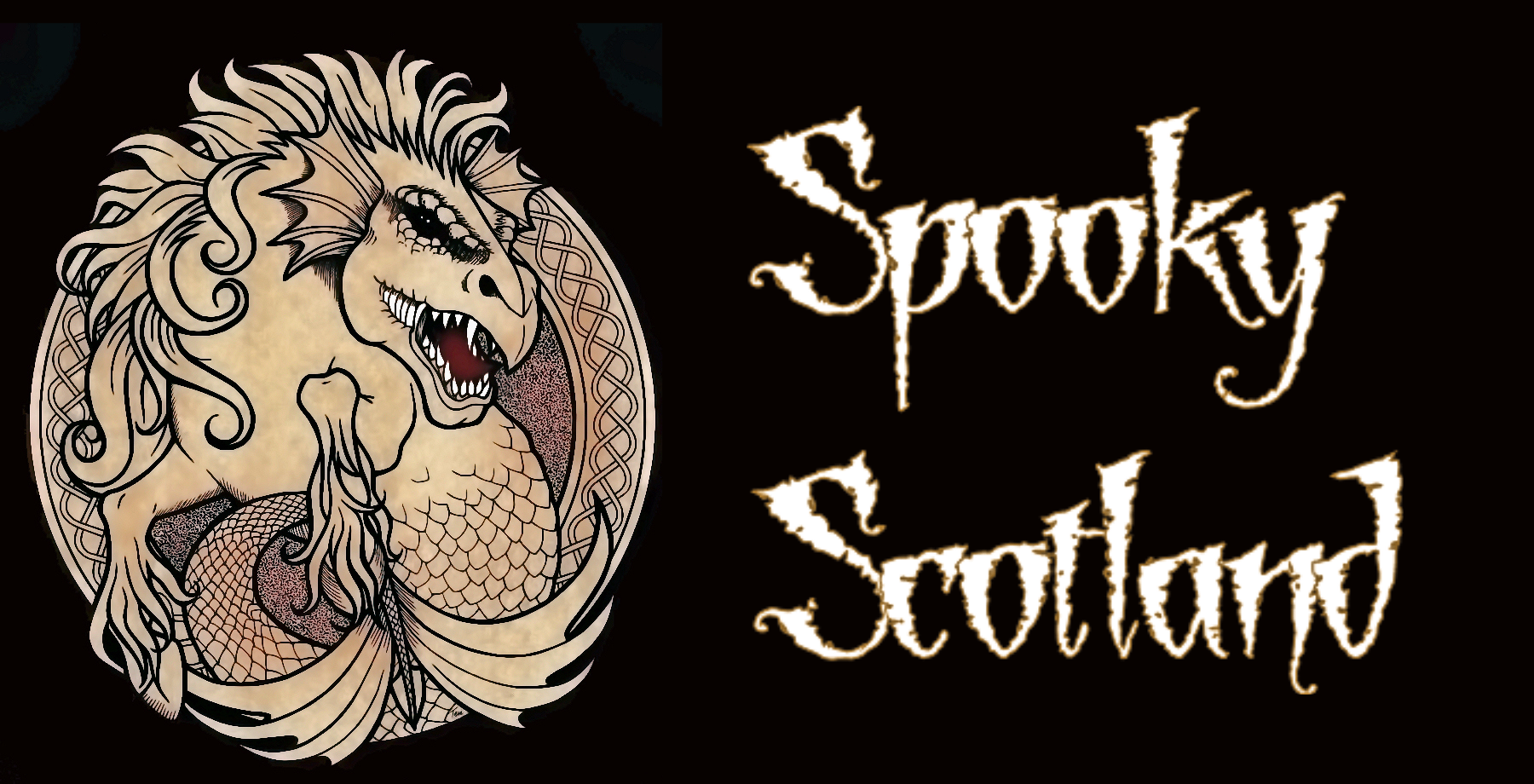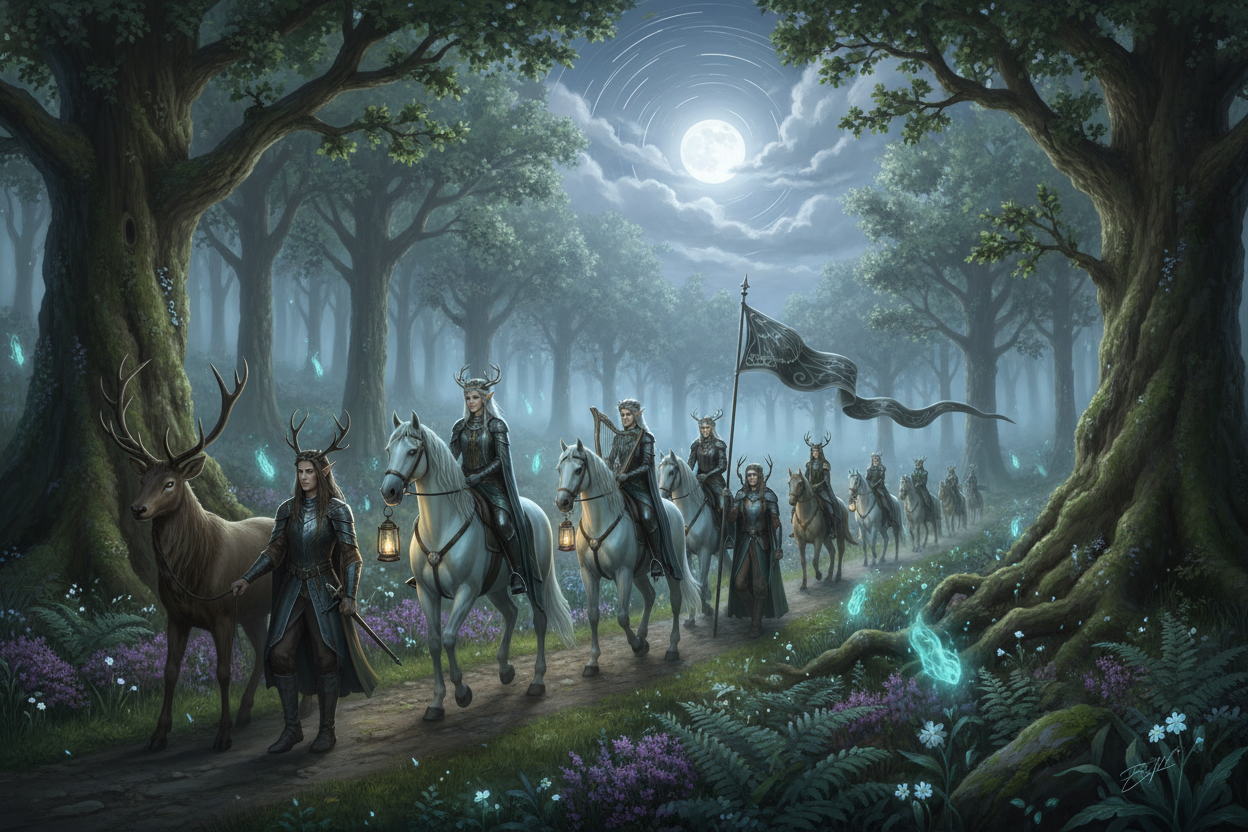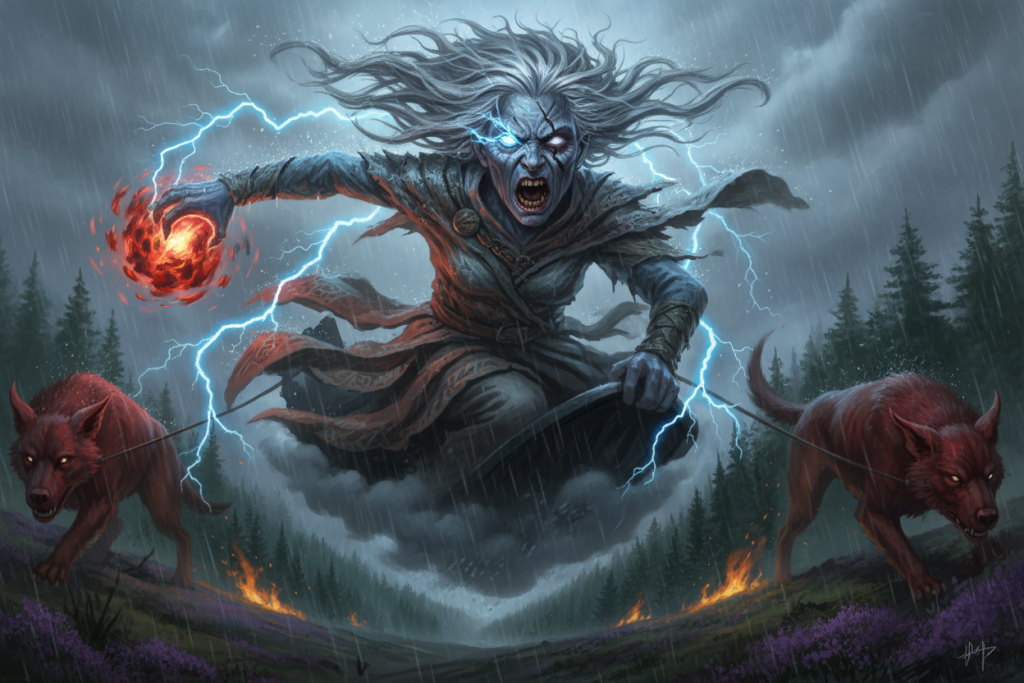The faery tithe is something that is uniquely Scottish. Faeries are found not only in Scottish folklore but in wider Celtic mythology, Norse, German and Slavic mythology. This is part three of our exploration of faeries. In Part One, we looked at the origins of faeries in Scottish myth and the frequently uneasy relationship between humans and the faery folk. In Part Two, we investigated Faery Life and discovered that the fun-loving fair folk were not above luring or abducting talented musicians to provide the entertainment at their feasts and dances.
However, some humans were kidnapped not for entertainment purposes but for a more sinister reason- to pay a debt in mortal coin- the hell tithe.
The Tale of Thomas the Rhymer
The earliest account of a faery tithe involves a real person. Sir Thomas de Ercildoun (Earlston) was a Laird from Scotland’s Borderlands in the 13th Century. He is also known as Thomas the Rhymer, Thomas Learmont or True Thomas. He was reputed to have the gift of prophecy bestowed upon him by his faery lover, and his prophetic utterances were given in the form of poems, hence his nickname Thomas the Rhymer.
Thomas was resting under the Eildon Tree when a lady on a white horse rode out from the green hill. She said she was the Queen of Elfland. Thomas was drawn to her and went with her beneath the hill to her country.
On the way, she showed him three roads. One was narrow and rough with thorns. She said it led to Heaven. One was broad and easy. She said it led to Hell. The third wound fair and quiet through the fern. She said it was the road to Elfland, which was neither of the other two. Thomas followed her along that road.
Thomas the Rhymer in Elfland
In Elfland, he stayed as the Queen’s companion and lover. For seven years, he lived beneath the hills, yet here time passed differently beneath the hills. Some say it felt like three years, others three nights. Though the place was pleasant, the Queen warned him that at a set time, the foul fiend would come to take his fee or tithe from among the fairies. She feared Thomas would be chosen because he was a fine mortal man. To save him, she said he must return home.
Before he went, she bargained on him. He must never tell a lie. In return, he would have the gift of prophecy. Then the hill opened, and Thomas stood once more under the Eildon Tree, the ordinary wind on his face.
From that day, he spoke only the truth and foretold what was to come. People called him Thomas the Rhymer, the man who had gone to Elfland and come back with second sight.
What is the Hell-tithe?
What was it that the Queen feared so much that she was willing to give up her human lover? Faeries are said to owe a periodic “tithe” (Scots: teind/tiend, i.e., a tenth) to Hell, paid as a living sacrifice. The hell-tithe motif is rare and shown only in three lowland sources. The first is in the tale of Thomas the Rhymer. The other is found in a similar ballad, The Ballad of Tam Lin. The third is taken from a testimony in a Witch Trial.
Faery Origins
In Scotland, faeries would have originated from pre-Christian gods, spirit guardians, animism and ancestor veneration. When Christianity came along, there could only be one God. However, it is hard for people to give up generations of belief and folk magic. Thus, the early Celtic Church began a process of merging two belief systems. Churches were built on sacred sites. Wells dedicated to the old gods became holy wells dedicated to saints and capable of healing. Some old gods were demoted to saints, where they could still be venerated but not worshipped as the one true God. Faeries became a way to demonise the older spirits, while still allowing people to hold onto their folk beliefs.
They wouldn’t have been called faeries then, but Sidhe- named after the mounds that they were said to live in, at least amongst the Gaelic-speaking population, which by 900 CE would have included a large portion of what we now call Scotland. The word faery comes from the French fae, which meant a ‘supernatural being’. This word arrived in the British Isles sometime after the Norman Conquest in 1066 CE. Faerie meant the land of the fae or the enchantment rendered by a fae. The word fae has its origins in the Latin fata or Fate, for in Roman belief, fate meant supernatural beings connected to destiny. Destiny, in this older sense, was not a vague prediction but a binding order of things—a law the Otherworld itself obeyed. The Sidhe were powerful, but not free of fate; they moved within obligations as surely as mortals did.
Changing Relationships
As the old gods receded into the hills and the Sidhe became the hidden neighbours of the living, the relationship did not end; it changed form. What had been worship became wary observance- milk left at the threshold, iron kept at the bedstead, and stories that taught when to yield and when to refuse. Out of these boundaries emerged the most ominous obligation of all: the faery tithe. And it is in the old ballad of Tam Lin that this due is named most plainly, for every seven years the Queen of Fairies must pay her teind—and this time, she has marked a mortal.”
The Ballad of Tam Lin
The Border ballad ‘Tam Lin’ gives the clearest account: every seven years a tithe is paid, and this time the Fairy Queen has set her claim on a mortal to meet the due.
Janet of Carterhaugh was a wilful young woman. Despite being warned that she should avoid the woods of Carterhaugh, the ballad tells us:
“Janet has kilted her green kirtle
A little aboon her knee,
And she has broded her yellow hair
A little aboon her bree,
And she’s awa to Carterhaugh
As fast as she can hie.”
It is said that the woods are guarded by a fairy knight who demands a boon from any maiden who wanders there. This may be an article of her clothing, a ring or even her virginity. Janet, it seems, is looking for an encounter with the faeries, for she is dressed in green, a colour that is favoured by the fair folk. As Janet wanders through the forest, she plucks a double rose, and Tam Linn appears. He asks why she has come without his leave and taken what is his. Janet responds that Carterhaugh has been gifted to her by her father and that she will come and go as she pleases.
In the weeks that follow after her return home, Janet discovers that she is with child. When her father presses her to name the father, she refuses and says that it was a fairy knight. Once more, she heads into the woods, and as she picks flowers, Tam appears. He reveals that he was once a mortal man. One day, he had been riding on his horse with his grandfather when he fell. The Queen of faeries caught him and carried him away. He has been held captive in the Carterhaugh Woods ever since.
Faery Tithe
Tam goes on to explain that he fears for his life. Halloween is fast approaching, but this is no ordinary Halloween, but a Halloween at the end of a seven-year cycle- the year of the Faery Teind (tithe). The faeries are bound at Midnight on every seventh Halloween to pay one of their own to Hell. Tam is sure that he will be picked, and he pleads with Janet to help free him. On Halloween Night, a cohort of faeries will pass through the Carterhaugh Woods. Tam will be easily recognisable from his white horse. She must be the one to catch him and hold onto him. He tells her that the Queen of Faeries will try to turn him into all kinds of beasts, but she must not let go. When he turns into a burning coal, she must throw him into a well.
When Halloween comes, Janet is ready and waiting for him. She pulls him off his horse. The Queen of the Faeries turns him into a snake, then a bear, then a lion and then a hot iron. Finally, he is transformed into a burning coal. Janet throws him into the well, where he is transformed into his human self, naked and exposed. Janet covers him with her mantle.
The faerie queen is furious, but Janet has freed Tam Lin and they can raise their child together. Tam is a nobleman and, therefore, a worthy match for Janet. Here, the faaery tithe is explicit: the faery court must pay a soul to Hell every seven years. Janet’s rescue circumvents that debt.
Recurring Motifs: Tam Lin and Thomas the Rhymer
Both tales turn on the seven-year rhythm of the Otherworld. In Tam Lin, the teind is due at Samhain and a mortal is marked for payment. In Thomas the Rhymer, the seven years are a service in Elfland, with the tithe hovering as the Court’s ominous obligation. Each hero is a striking mortal of gentle birth—desirable to the fair folk and valuable as “the best” of their company. Yet their salvations invert one another. Tam Lin is wrested back by a human lover, Janet, through ritual courage at the liminal hour. Thomas is released by his faery lover, the Queen, and returns not freed but marked with the gift—and burden—of truth. In short, Tam Lin resists the tithe and restores mortal life; Thomas submits to faery time and brings its second sight home.
Faery Tithe and the Scottish Witch Trials
We also know that belief in the Faery tithe existed among the common folk at the time of the Scottish Witch Trials. Allison Pearson from Fife describes how she was taken away by the faeries who taught her the healing arts. Her uncle, William, told her to sane (bless) herself so ‘she be not taken away with them again, for the teind (tenth) of them go every year to hell.’
Significantly, around this time, in his book Daemonologie, James VI, King of Scots, states
‘…there was a King and Queene of Phairie, of such a jolly court and train as they had, how they had a teynd (tithe), and a dutie, as it were, of all the goods: how they rode, went, eate and drank, and did all other actiones like naturall men and women.’
It seems that here he believes that it was the faerie King and Queen themselves who took the tithe rather than the devil. Why might this be?
A Faery Over-King Takes the Faery Tithe
It has been suggested that there was an overking among the faeries. We know that there are several Otherworlds and a multitude of Faery Kings and Queens, for faery lore is localised and attached to the landscape in which these tales are told. There is the Queen of Elfland, seen by Isobel Gowdie who lived under the Downie Hill near Auldearn, Donald Mor, King of the Faeries in the Cairngorms, and Iain Buidhe King of Land Under the Sea. But who is this Dark King- The Dark One, the Arch Fiend? Possibly it is Righ Dubh na Sithichean, king of the Night or a Scottish version of Crom Dubh from Ireland, who demanded human sacrifice.
This is highly speculative, but could the Black Fairy, Righ Dubh, God of Night be the same person as Domhnall Mor (Big Donald), King of the Sith? Consider that Loch Morlich, where Donald Mor lives, falls within the Strath Spey Area which runs between the two Craigellachie Hills on the River Spey, where Righ Dubh also lives. Black Donald (Domhnall Dubh or Domnuill-dhu) is a Highland colloquialism for the Devil in Scottish mythology. Is it possible that, as folklore has evolved, a juxtaposition of these characters has grown into the devil’s tithe from an older tradition where human homage was paid to an older spirit or God?
What might be the Purpose of a Faerie Over King gathering a Tithe?
It is said that the King of Faeries is gathering an army of warriors- sometimes giants! Across Scotland, there are tales of armies and giants sleeping below mountains or in caves. For now, this army lies asleep, waiting for a great battle. King Arthur and his Knights lie asleep beneath Arthur’s Seat in Edinburgh, or under the Lucken Hare, one of the three peaks of the Eildon Hill. Thomas the Rhymer is said to sleep below the Dunbuck Hill near Dumbarton and in the Eildon Hill. Sometimes it is Fionn MacCumhaill and the Fianna that rest beneath Tomnahurich Hill by Inverness, and sometimes it is Thomas the Rhymer. Fionn and his men lie asleep in the Cave of Craigiehow, Munlochy. Jock o’ Bennachie is said to rest under the hill, put there by a faerie woman.
Donald MacKenzie stated:
“All these sleepers are supposed to be awaiting for the day of a great battle. In their cave is a whistle or horn, and when it is blown three times, the heroes will come forth. Folk stories tell of men who have blown the whistle or horn twice. The first sound caused the sleepers to open their eyes and shake themselves; the second made them rise, resting on their elbows. The visitor is afraid to blow a third blast, being terrified by the ferocious appearance of the warrior. As he retreats the chief giant calls after him, “Wretch mischief-maker, you have left us worse than you found us”.
It is interesting that in both ballad tales, Tam Lin and Thomas the Rhymer are both knights, men who would have been trained in arms.
Human Substitutes
It has been proposed that the Faery tithe might explain the concept of changelings and why, sometimes, adults were taken. They were to be used as substitutes for the faeries themselves. Sometimes an unequal exchange took place. A thriving child is swapped for a withered “stock,” or a new mother is borrowed into service under the hill while a likeness lies wan at home. Adults can be taken too, especially at liminal moments—after childbirth, on the wedding night, or at the edge of death.
Changelings and the Faerie Tithe
Across Highland and Lowland tradition, families feared that a healthy infant might be exchanged for a fairy stock—an old being in the shape of a babe, fretful, wizened, and never satisfied at the breast. It was widely believed that unbaptised children were particularly vulnerable to being taken. People watched for sudden wasting, uncanny alertness, or speech beyond years. The following tale exemplifies this.
A Tale from Glenlivet
Two men from Strathspey made side money buying whisky in Glenlivet and selling it to gentlemen in Badenoch and Fort William. To avoid the excisemen, they always travelled at night. One night, while they were measuring out whisky at their friend’s house, his baby let out a sharp cry from the cradle. The mother quickly blessed the child and picked it up, then everyone carried on as normal.
Not far down the road, the men found a baby lying alone. When one of them lifted it, the child stopped crying and clung to him, smiling. Looking closer, they realised it was their friend’s baby. They suspected the fairies had tried to swap the real child for a changeling, but the mother’s blessing had forced the fairies to abandon the real baby on the road.
They were in a hurry, so they took the baby with them and finished their trip. Two weeks later, they returned to Glenlivet with the child, keeping it hidden. The mother, in tears, said her baby had fallen gravely ill the night of their last visit. Just then, the “sick” baby in the house began wailing, looking close to death.
A Revelation
The men revealed the healthy child they’d brought back and told her the truth. The baby in the cradle was a fairy impostor. The mother agreed to the exchange. As the men prepared a traditional “cure” for the changeling—setting a creel and straw by the fire—the impostor bolted up the ‘lum’ (the chimney). It vanished into the night, shouting that if not for those two travellers, he’d have given the household a very different sort of entertainment.
This tale could connect to the “faery tithe” tradition—the idea that fairies must periodically pay a tribute to the otherworld (often by taking a human). The attempted swap for a changeling fits the pattern of abduction to meet that due, with the mother’s blessing interrupting the tithe and forcing the fairies to abandon the real child. On the other hand, the story may be just a standard changeling motif rather than a tithe narrative: there’s no explicit demand, schedule, or bargain with the otherworld—only a thwarted abduction—so it reads more like a local cautionary tale about fairy mischief than evidence of a faery tithe.
Adult Kidnappings
Abduction stories often involve new mothers. In Aberdeen, Mary Campbell married John Nelson, a goldsmith. They were happy until the night of her first childbirth. Just before midnight, a dreadful noise shook the house, and every candle went out. When the lights were struck again, Mary lay motionless. The attendants thought she was dead. John was shattered, but as he looked at her, he insisted something was wrong—that this wasn’t truly his wife. “The fairies have taken her,” he said, “and left a lifeless stock in her place.” Few believed him, and the body was buried.
Days later, riding at dusk, John heard unearthly music and saw a veiled woman in white. He greeted her, and she lifted her veil, weeping: it was Mary. She told him she wasn’t dead at all—the fairies had seized her at the hour of birth and left only a substitute. Their child, she said, was alive too, nursed by three attendants in the fairy court. She could be won back if her brother Robert, a sea captain due home in ten days, followed directions that would appear as a letter on John’s desk. Before vanishing, she told John to go to the fairy moat and demand she be spared punishment. He rode there at once, threatened to burn the thorns and brambles if any harm came to her.
A Letter Appears
On Sunday morning, the promised letter appeared, addressed to Robert. It instructed him to stand at the centre of the moat at midnight, call Mary, seize the woman in the whitest dress, and never let go, no matter what terrors arose, until the cocks crowed.
Robert returned, read the letter, and went alone at the appointed hour. He faced roaring phantoms—a lion, thunder, fire, and swarming monstrous shapes—but he held Mary’s hand through it all. At first light, the illusions vanished. He wrapped her in his own coat, binding her safely to the human world, and brought her home to John amid great rejoicing.
John, still adamant that the fairies had taken their child, vowed to tear down the moat. A voice warned them instead: leave the ground within three perches of the moat untilled and do not harm the brambles, and the baby would be returned unharmed. They agreed. Moments later, their infant was laid on Mary’s knee, alive and well.
Parallels With Tam Lin
The Aberdeen tale mirrors Tam Lin in striking ways. Both feature a midnight rescue at a liminal fairy place, where the rescuer must hold fast through a barrage of terrifying illusions until the cocks crow. In Tam Lin, Janet endures shape-shifts to win Tam back; here, Robert grips Mary’s hand as fire, thunder, and monstrous apparitions rage around him. The visible fairy court—king, queen, attendants—reinforces the shared setting of a mound or “moat” where the otherworld breaks into ours. Protective tokens also align: Robert’s coat fixes Mary to the human world, just as Janet threw her mantle over Tam Lin.
Whether these point to the faerie tithe is less certain. Tam Lin explicitly ties the rescue to preventing a periodic tribute—the “tithe to Hell” or to the Otherworld—usually due at Hallowe’en. The Aberdeen story never mentions a schedule, a deadline, or a due. It explains the abduction by fairy power, not by obligation. Still, the coordinated midnight taking of mother and child and the formal presence of the fairy court leave room for a tithe reading, if one is inclined to see the fairies collecting valuable human lives.
Animal Thefts
It is not just humans that are taken by the Sithichean- animals may be taken too. A farmer from Auchriachan in Strathavon went looking for his goats on a remote Glenlivet hill and got lost as night fell. Seeing a distant light, he headed toward it and found a strange, forbidding place that looked untouched by humans. Inside, to his shock, he met an old acquaintance whose funeral he’d recently attended. She rushed him into a side corner and whispered that he was in grave danger unless she hid him until he could slip away.
From his hiding spot, he watched an immense gathering of faeries flood in, clamouring for food. They cursed him as a miser who never left them their dues, saying his usual protections kept them at bay—but tonight his family had forgotten, so they would take his favourite ox and his wife’s bannocks. He saw them slaughter the ox and roast it. While they feasted, the dead housekeeper spirited him out of what she called “Mr Rhymer’s council-chamber”—a startling nod to Thomas the Rhymer, far from his Borders haunts.
The farmer made it home and killed the “stock” the fairies had left in place of his ox. The carcass tumbled down the hill and lay untouched—neither dog nor cat would eat it.
The Fairy Rade
Twice a year, the Faeries ride out, a moving company of riders and runners that the land at speed. Usually this happens at dusk, midnight, or the turn of seasons. People hear it before they see it—bits of bridle and bell, a wind like wings, hoofbeats that don’t quite touch the ground. Lights may move with it, blue‑white as foxfire. This is the Faery Rade- a hunt led by their queen. Pretty children are claimed along with musicians and those with talent.
A Tale from Nithsdale
An old woman of Nithsdale told how, on the night before Roodmas, she had arranged to meet a neighbour lass a Scots mile from home to talk about buying finery for the fair. They had not been long under a hawthorn when they heard laughter, the jingling of bridles, and the clank of hoofs. Thinking drunken folk were riding to the fair, they sprang up—then saw it was the Fairy Rade.
They crouched until it passed. A beam of light went over the riders, lovelier than moonshine. All were very small, in green scarves, except for their leader who was taller than the rest with long fair hair bound by a strap that shone like stars. They rode white ponies with sweeping tails. Their manes hung with whistles that the wind played, and their singing sounded like a far‑off psalm. The women were in a broad lea-field as the company came by. The riders leapt a high hawthorn hedge like sparrows and galloped to a green knoll beyond. In the morning, the two went to look for hoof marks in the trampled corn. Surprisingly, there was not a print nor a broken blade.
But what is the purpose of the Faery Rade? Is it to gather human replacements for the faery tithe? Or is it to gather the resources they desire from humankind- bonnie babies, wet nurses and midwives and those who can entertain them? Perhaps a bit of both.
Protection Against Faeries
It is possible to protect yourself against the Sithichean and not be carried away to their mounds. Protection starts at thresholds- keep iron at doors and windows. Put a pin, nail, or small key in the cradle. Hang rowan at the lintel and a tiny rowan cross tied with red thread on a baby’s cot. Salt by the hearth and bed, a spoken blessing for newborns, and a candle or company on the first nights all help. Avoid boasting of a child, and never eat or drink in an uncanny place. If you fear a changeling, don’t use harsh tests. Set iron nearby, speak the baptismal name, use a quiet prayer or sprinkle of holy water, and take the child to running water at dawn, where custom allows.
Offer courtesies outside—milk on a clean stone, a crumb of bannock—without inviting bonds indoors. For kidnappings and the faerie tithe, watch times and paths. Samhain and Beltane are the riskiest. Carry rowan, salt, and a turned-inside-out garment.
The Faery Tithe: Important to Scottish Lore
The faery tithe sits at the centre of a small but important strand of Scottish lore. In the ballads of Thomas the Rhymer and Tam Lin it appears plainly. In changeling tales and local reports, it’s more of a shadow behind abductions and swaps. Taken together, the stories show a practical rule set. Respect boundaries, mind liminal nights like Samhain and Beltane, keep thresholds protected, and don’t bargain carelessly. People left small offerings outside and kept iron and rowan at hand. The aim wasn’t romance—it was getting everyone home safe.




